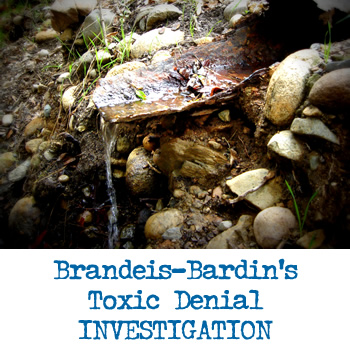+++
MCPP (Mecoprop) BTV: 284 ppb
MCPP (Mecoprop) Brandeis-Bardin: 1300 ppb or 4.6 TIMES AREA IV BTV
[HERBICIDE – http://www.cdc.gov/niosh/ipcsneng/neng0055.html:
“The substance can be absorbed into the body by inhalation of its aerosol, through the skin and by ingestion.”
&
“Mecoprop is a chlorophenoxy-herbicide which, as a group, has been classified by IARC (1987) as possibly carcinogenic to humans, but the data on this specific substance are inconclusive.”]
+++
MIREX BTV: 0.398 ppb
Mirex Brandeis-Bardin: 0.62 ppb or 1.6 TIMES AREA IV BTV
[HERBICIDE – https://www.atsdr.cdc.gov/toxfaqs/tf.asp?id=642&tid=118:
“Exposure to mirex and chlordecone occurs mainly from touching or eating soil or food that contains the chemicals. At high levels, these chemicals may cause damage to the skin, liver, or nervous and reproductive systems. Mirex has been found in at least 7 of the 1,430 National Priorities List sites identified by the Environmental Protection Agency (EPA); chlordecone has been found at 2 sites.”
&
“Mirex and chlordecone have not been manufactured or used in the United States since 1978. Mirex was used to control fire ants, and as a flame retardant in plastics, rubber, paint, paper, and electrical goods from 1959 to 1972.”
“Mirex and chlordecone break down slowly in the environment, and they may stay for years in soil and water. They do not evaporate to any great extent from surface water or surface soil. Mirex and chlordecone do not dissolve easily in water, but they easily stick to soil and sediment particles.”
&
“How might I be exposed to mirex and chlordecone?
Touching or ingesting contaminated soil near hazardous waste sites.
Ingesting contaminated fish or other animals living near hazardous waste sites.
Nursing infants of mothers living near hazardous waste sites may be exposed to mirex through their mothers’ milk.”
&
“Animal studies have shown that ingesting high levels of mirex can harm the stomach, intestine, liver, kidneys, eyes, thyroid, and nervous and reproductive systems.”
&
“How likely are mirex and chlordecone to cause cancer?
The Department of Health and Human Services (DHHS) has determined that mirex and chlordecone may reasonably be anticipated to be carcinogens.
There are no studies available on whether mirex and chlordecone are carcinogenic in people. However, studies in mice and rats have shown that ingesting mirex and chlordecone can cause liver, adrenal gland, and kidney tumors.”]
DELTA BHC BTV: 0.164 ppb
Delta BHC Brandeis-Bardin: 0.74 ppb or 4.5 TIMES AREA IV BTV
[PESTICIDE – https://cameochemicals.noaa.gov/chemical/16177:
“Poison”
&
“Slightly musty odor.”
&
“ACUTE/CHRONIC HAZARDS: Highly toxic. May cause irritation on contact. Hazardous decomposition products. (NTP, 1992)”
&
“Since this chemical is a known or suspected carcinogen you should contact a physician for advice regarding the possible long term health effects and potential recommendation for medical monitoring.”
+++
FLUORENE BTV: Drainage 2.83 ppb
Fluorene Brandeis-Bardin: 8.7 ppb or 3.1 TIMES AREA IV BTV
[PAH – http://www.cdc.gov/niosh/idlh/7782414.html:
“Immediately Dangerous to Life or Health Concentrations (IDLH)”
&
“Pale-yellow to greenish gas with a pungent, irritating odor.”
With:
https://www.atsdr.cdc.gov/toxprofiles/tp69.pdf:
“Fifty-four PAHs have been identified at one or more NPL hazardous waste sites. These 54 are… fluorine.”
“Both male and female mice exposed to 250 mg/kg/day fluorene exhibited hematologic effects, including decreased packed cell volume and hemoglobin content (EPA 1989e).”
&
“Increased relative liver weight was observed in all treated groups, whereas increased absolute and relative liver weight was observed in the mid- and high-dose animals receiving 0, 125, 250, and 500 mg/kg/day fluorine for 13 weeks (EPA 1989e).”
&
“Administration of 51.4 mg/kg/day acenaphthene or 180 mg/kg/day fluorene resulted in statistically significant increases in liver weight compared to controls, which may have indicated an effect on regeneration, although rates of cell proliferation were not determined.”
&
“After administration of 500 mg/kg/day fluorene for 13 weeks; however, female mice exhibited increased body weight, although male mice showed no effect at the same dose level (EPA 1989e).”
&
“After administration of 2.50 mg/kg/day fluorene for 13 weeks, however, increased absolute and relative spleen weight was seen in both sexes (EPA 1989e).”
“Fluorene.
• An MRL of 0.4 mg/kg/day has been derived for intermediate-duration oral exposure (15-364 days) to fluorene.
The MRL was based on a minimal LOAEL of 125 mg/kg/day for relative liver weight (EPA 1989e). Four groups of CD-l mice (20/sex/group) were gavaged daily with 0, 125, 250, or 500 mg/kg/day fluorene for 90 days. The toxicological evaluations of this study included body weight changes, food consumption, mortality, clinical pathological evaluations (including hematology and clinical chemistry), organ weights and histopathological evaluations of target organs. The results of this study indicated no treatment-related effects on survival, body weight changes, total food intake, or ophthalmological alterations. All treated male mice exhibited increased salivation, hypoactivity, and urine-wet abdomens. A significant decrease in red blood cell count and packed cell volume was observed in females treated with 250 mg/kg/day and in males and females at 500 me/kg/day. Decreased hemoglobin concentration was also observed in the high-dose group. A dose-related increase in relative liver weight was observed in all treated mice, and in absolute liver weight at >250 mg/kg/day. A significant increase in absolute and relative spleen and kidney weight was observed at 250 mg/kg/day.. Increases in absolute and relative liver and spleen weights at the high dose were accompanied by histopathological increases in hemosiderin in the spleen and in the Kupffer cells of the liver. The LOAEL is 125 mg/kg/day based on increased relative liver weight. There was no NOAEL. The MRL was obtained by dividing the LOAEL value by 300 (3 for a minimal LOAEL, 10 for extrapolation from animals to humans, and 10 for human variability) and rounding to one significant figure.”
&
“Fluorene is used as a chemical intermediate in many chemical processes, in the formation of
polyradicals for resins, and in the manufacture of dyestuffs (Hawley 1993; HSDB 1994).
Phenanthrene is used in the manufacture of dyestuffs and explosives and in biological research
(Hawley 1987; HSDB 1994). Fluoranthene is used as a lining material to protect the interior of steel and ductile-iron drinking water pipes and storage tanks (NRC 1983).”
“Fluorene from an abandoned creosote pit was found to migrate through sand and clay into groundwater (Wilson et al. 1986). PAHs have also been shown to be transported laterally within contaminated aquifers (Ehrlich et al. 1982).
&
“Anthracene, acenaphthene, fluorene, and phenanthrene are chemical intermediates used in the manufacture of dyes, plastics, pesticides, explosives, and chemotherapeutic agents (Hawley 1987; HSDB 1992; Windholz 1983).]
*Public photographs of a Brandeis-Bardin Campus survival camping class March 2, 2008 are reprinted through Fair Use and credited to Danielle D.
27 Years of Award-Winning SSFL/Rocketdyne Reporting
1998 – 2025



















Recent Comments